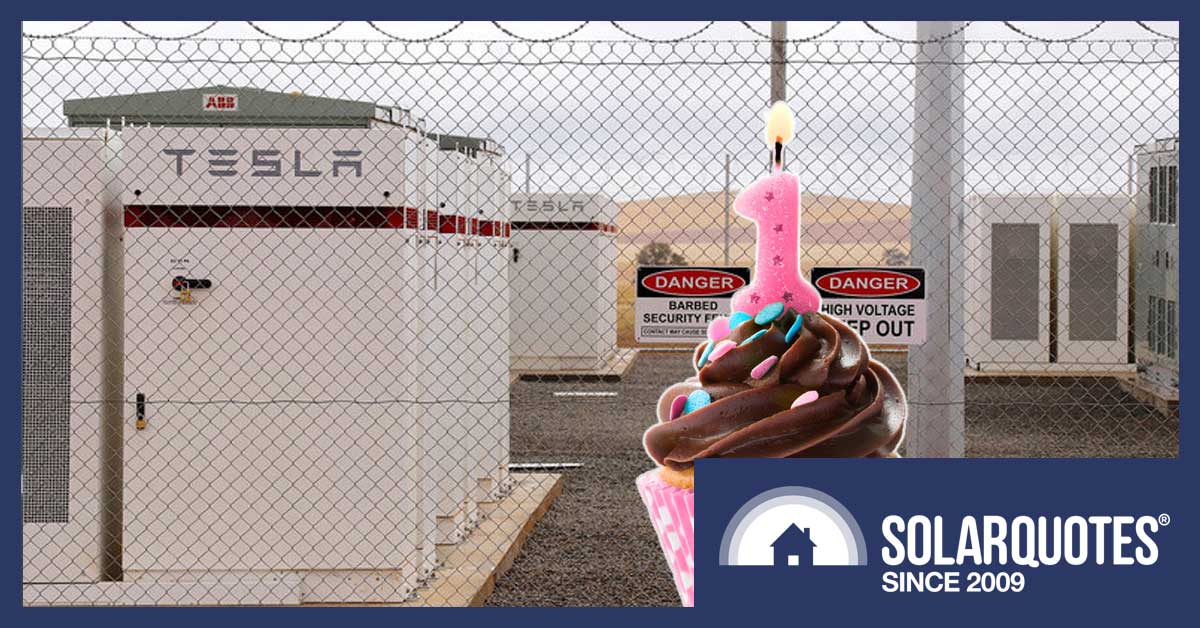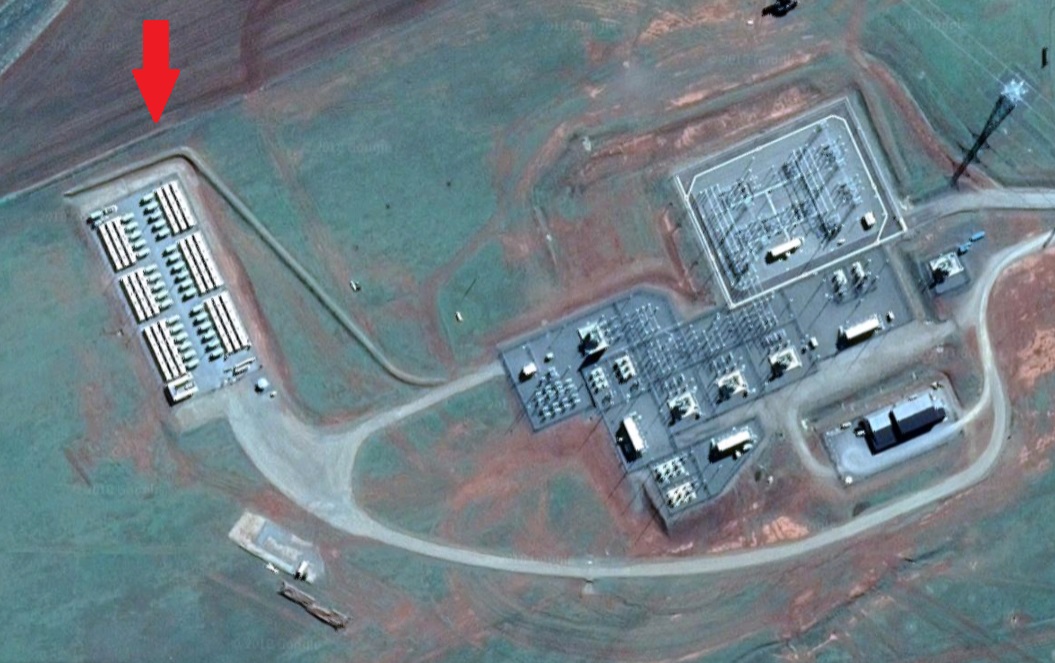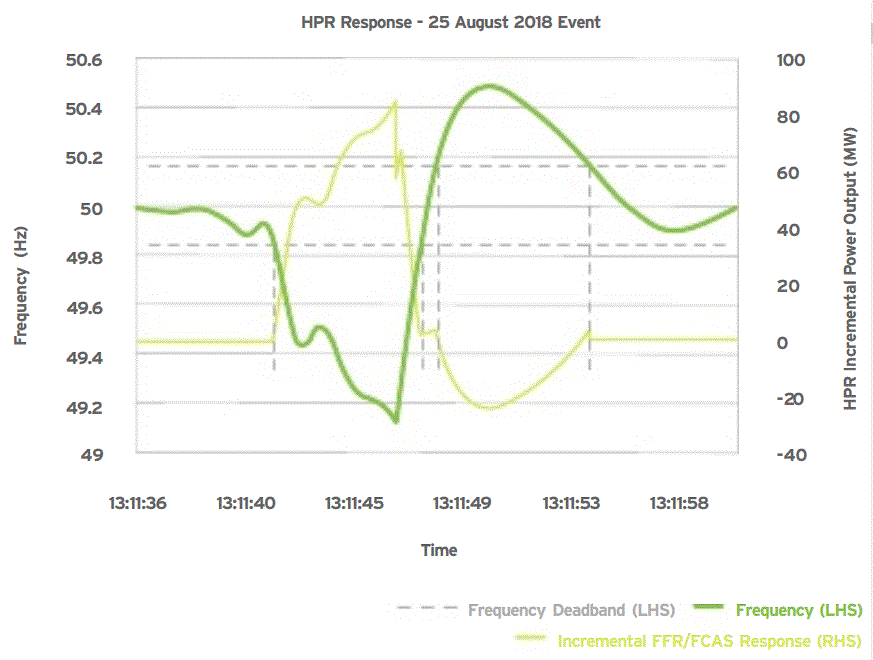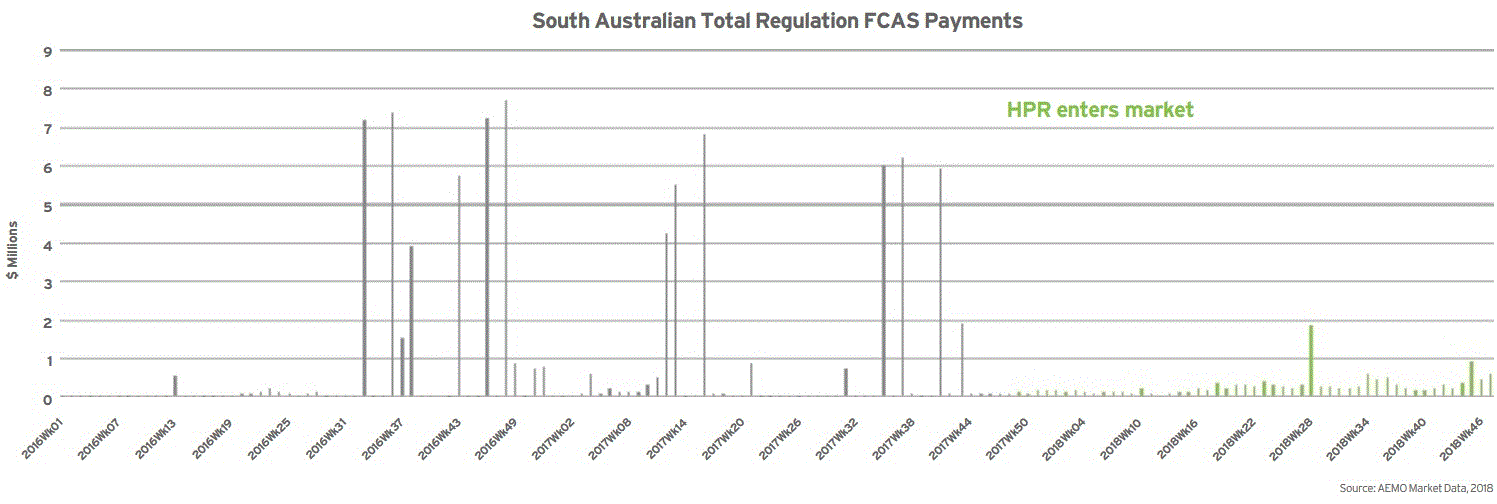
The Hornsdale Power Reserve or “Tesla Big Battery” is One! And it’s been quite successful.
The Tesla Big Battery in South Australia came online last year on the first of December. It’s now one year and 18 days old. Despite the involvement of Elon Musk and Tesla it’s not actually called the Tesla Big Battery. Its real name is the Hornsdale Power Reserve. Personally, if I had been asked, I would have called it Elonia Princess of Power, but I wasn’t consulted and so my naming talents continue to be squandered.
But what it’s called is not important. A rose by any other name would smell as sweet.1 The real question is, how well has the Hornsdale Power Reserve performed over the past year? Has it been a massive waste of money or was it only a moderate waste of money? Or has it actually been a sound investment?
The good news is that it works, and — despite my misgivings — it is making the company that owns it lots of money and helping lower the cost of electricity for all South Australians. Whether or not we would have been better off with a different approach, such as getting a better price by waiting and not being in such a damn rush is not clear to me. I’ve looked through the Hornsdale Power Reserve Year 1 Technical and Market Impact Case Study to try to find an answer and all I can come up with is a vague maybe. If I was smarter I’d be able to give a better answer. Perhaps a super definite maybe. But I ate a few too many paint chips when I was a child — and for breakfast this morning — so a vague maybe is the best I can do.
I have put highlights from the report below so you won’t have to read the whole thing yourself . Unless of course you want all the details and would prefer not to be distracted when I start babbling about Princesses of Power2 and other nonsense.
In this article about the Hornsdale Power Reserve I will tell you:
- Where it is.
- How big and powerful it is.
- How it was made by an American company and stuffed full of Korean battery cells.
- Who owns it.
- How much it cost.
- How it supports the grid and protects us from blackouts.
I’ll also complain about how stupid we were to let the electricity sector get into the state it’s currently in, but that can probably be taken as given and safely ignored.

“Do I make you Hornsdale, Baby? Do I?”
Location — It’s In Hornsdale, Baby!
The Hornsdale Power Reserve is — prepare to be shocked — in Hornsdale. While it was under construction some nong tried to tell me it was in a secret location, but as it was built right next to the Hornsdale wind farm’s electrical substation — which was the only sensible position — it was basically the worst kept secret ever. (Apart from the secret that resulted in my first divorce, but I’m sure you already know the details of that. Everyone seems to.)

The Hornsdale Power Reserve was constructed immediately south of a large red arrow. Or maybe this just a decoy to protect its secret location? It could be behind you right now! (Image: Google Maps)
The Biggest Battery In The World!
It’s been over a year and the Hornsdale Power Reserve is still holding firm onto its position as the world’s largest battery. This may change in a couple of years and depending on which big battery project gets completed first, the one that deposes it could be a 120 megawatt battery in South Australia’s Port Augusta. It’s enough to make you think the state has a big, beautiful battery fixation.
The Power Reserve can supply 100 megawatts of power. That’s easy to write, but the hard part is coming up with a way to put that in context and help you visualize it. Sure, I could say it’s more than the average power consumption of 100,000 homes or equal to the draw of 67,000 electric kettles, but that doesn’t really tell you anything particularly useful. I mean, how often do people run up to you and scream, “I have 66,000 electric kettles I need to boil all at once and the Hornsdale Power Reserve! Give it to me straight, man! Do I have enough power?”
Perhaps a useful way to look at it is, during a heatwave South Australia’s grid maximum grid power draw tops out at around 1.7 kilowatts per person. This means the Hornsdale Power Reserve could meet the needs of 59,000 people which is around 3.4% of the population. That may not seem like a large portion of the people in the state, but every bit helps. And trust me, if 59,000 thousand people went without power the amount of whinging we’d hear about it would be unbelievable. And most of that whinging would come from Canberra rather than South Australia.
129 Megawatt-Hours Of Energy
The Power Reserve can supply up to 100 megawatts of power and can store 129 megawatt-hours of energy. This means it could supply its maximum power output for 1 hour and 17 minutes.3 Or at least it could when brand new. Like all lithium batteries its capacity will gradually deteriorate with time and use. But mostly use.
American Ingenuity, Korean Guts
The Power Reserve was built by Tesla, but Tesla didn’t have an adequate supply of the the battery cells they would normally use for this type of project, so they bought them from the South Korean company, Samsung. Fortunately, there’s no need to worry because Samsung has totally solved the battery problem shown below…
The battery cells in the Power Reserve aren’t even the same type as the one exploding in the video. And the factory that made the defective batteries caught on fire anyway. Not that I’m suggesting exploding batteries are a problem that is self correcting, but the good news is it has been corrected.
French Owned
While it was built by Tesla the Power Reserve is owned by the French renewable energy company Neoen4, which owns the Hornsdale wind farm it’s next to. According to them it cost 56 million Euros. At today’s exchange rate that’s $89 million Australian. That comes to $690 per kilowatt-hour of storage, which is ridiculously expensive considering at the time the Tesla Powerwall 2 was selling for just $642 per kilowatt-hour. You’d think such a large scale order would cost less, not more, wouldn’t you?
But apparently no one made a better offer that fit the requirements — so if we wanted a big battery in 100 days from the contract being signed, as Elon Musk promised, that’s probably what had to be paid. I also doubt Tesla was making any money on Powerwall 2s at their original price, hence the multiple Powerwall price hikes since then.

Neoen some friends.
We Pay A French Company To Use Their Battery
The South Australian government is paying the French company Neoen $4 million a year over 10 years to let the government use 70 megawatts of power and 10 megawatt-hours of energy storage of the Power Reserve to provide ancillary services that help stabilise the grid. The remaining 30 megawatts of power and 119 megawatt-hours of energy storage can be used however Neoen wants. One estimate is they will make a gross margin of around $18 million a year from storing electricity when it’s cheap and selling when the price is high, which is generally in the late afternoon and evening when rooftop solar output is either low or zero.
So it looks like a battery that cost them $89 million will make them over $20 million a year. This return will fall as more battery capacity is built, but it still seems pretty sweet.5 Just to be clear, the $4 million a year payment from the SA government appears to have been the only financial incentive Neoen needed to have Tesla build the battery for them.
Why Isn’t It Government Owned?
You might be wondering why the SA government is renting battery space off a French company instead of having their own. This is because they are not allowed to interfere in electricity markets. If you are wondering who made that rule, they did. The privatization of the electricity sector created a situation where the state government has next to no control over the provision of electricity but they still get the blame when something goes wrong. This is one reason why I was concerned about the construction of the big battery. I thought they might be willing to pay more than it was worth if it would help them avoid the political fallout from power failures.
It Protects Us From Blackouts
On December the 14th last year an old, unreliable, coal power generator in Victoria went offline and 560 megawatts of power was suddenly lost. The Hornsdale Power Reserve, which had only started operation two weeks earlier, was able to provide power to help make up the shortfall in a fraction of a second. This was far faster than the 6 seconds required by the coal power station in Queensland that had the job of providing spinning reserve6 to make up for sudden shortfalls in power supply. While this wasn’t necessary to prevent a blackout it did demonstrate the system worked.
But on the 25th of August this year the Power Reserve prevented load shedding. Load shedding is how my first wife described our divorce. It also refers to cutting grid power to customers. There is voluntary load shedding where large users of electricity agree to have some of their electrical equipment automatically shut off and then there’s blackouts where grid power simply stops.
The problem was apparently caused by lightning hitting powerlines in northern NSW. This was enough to break the world’s longest electricity grid into three pieces and really rub in that our grid isn’t the most robust in the world. Queensland and South Australia had their power interconnectors with other states shut down and were forced to get by on their own. SA was importing power from Victoria at the time so there was a shortfall, but the Power Reserve was able to respond in around one tenth of a second. (By pure coincidence, “one tenth of a second” was one of my first wife’s nicknames for me. That and “paint chip boy”.) The graph below shows what happened:
The green line shows the frequency of the South Australian grid dropping after power from Victoria was cut off. The yellow line shows the Power Reserve rapidly reacting and dragging the frequency back up in under 10 seconds. No load shedding was required in SA as a result, unlike what happened in Queensland, NSW, and Tasmania as a result of this event.
It Lowers The Cost Of FCAS
When the Hornsdale Power Reserve acts to keep the grid frequency within acceptable limits it provides Frequency Control Ancillary Service or FCAS for short. FCAS is normally provided by fossil fuel or hydroelectric generators. In South Australia limited competition greatly increased the cost of providing FCAS and this raised electricity prices by a small but real amount. So one could quite honestly say South Australia’s electricity prices were FCASed up. But since the Power Reserve began operating FCAS costs have dropped dramatically as this graph shows:
As you can hopefully see, FCAS payments are low at first until decreased competition enables them to soar and then after the Hornsdale Power Reserve comes online they fall to a much more reasonable level.
The decreases in the cost of FCAS will reduce electricity bills. It will only be a small change, but it will be passed on. The electricity sector won’t be able to keep it as extra profit for themselves because the system works. It’s a horrible, miserable system that causes a great deal of suffering that we never should have made in the first place, but it does function. So it’s quite similar to my first marriage.
It Makes The Electricity Market More Competitive
If we ignore that it slurps up electricity when it’s cheap, the portion of the Power Reserve that is controlled by the French7 operates like a power station. Because the South Australian electricity market is lacking in competition, this additional source of power helps keep electricity prices down. It also helps increase electricity prices when it vampirically sucks up cheap energy, but it should help a lot more than it hurts.

Battery vampires drain your blood when it’s cheap and sell it back when the price is higher.
It Aids Renewable Integration
In the past I have mentioned that even in South Australia where over half the electricity generated in the state comes from wind farms, rooftop solar, and solar farms, very little clean energy is lost. Even when SA is producing far more energy than it can use the excess can normally be exported to Victoria. But this won’t last for long. In just two years 73% of electricity generated in the state is expected to come from renewables and no new transmission capacity will come online in that time. This means there is certain to be excess clean energy the Power Reserve and other batteries will be able to soak up and store for later use that otherwise would have gone to waste.
It Shows The Rules Need To Be Changed
The Hornsdale Power Reserve has demonstrated that when the grid frequency starts to drop batteries can FCAS things up faster than any traditional method. But at the moment the payments received for a tenth of a second reaction time and six seconds are the same. Because they provide a better service, batteries could receive a better payment. On the other hand, batteries are clearly going to largely take over in this area anyway and so there may be no need to shovel extra money their way. But generally speaking, getting incentives right will help improve efficiency. It’s just a matter of actually getting them right.
I mentioned earlier that as installed battery capacity increases returns will decline. But there is one rule change already in the works that will provide a big boost to their profitability and this is the change from half-hour to 5 minute payment periods. Because batteries can respond very rapidly this will give them an advantage over less nimble generators that have to make things spin in order to provide power.
The Hornsdale Power Reserve Is Not A Disaster
I was concerned the big battery would be a waste of money, but now I can see it has lowered the costs of FCAS and is being successfully used for electricity arbitrage and so it appears to be a success. But I still can’t be certain we wouldn’t have been better off waiting for a lower price or building a smaller battery and expanding later as needed.
It’s just a pity that a lot of its success is based upon the fact that we’re so stupid. If we hadn’t allowed competition to become so limited, FCAS payments and wholesale electricity prices would never have risen so high. And if our politicians hadn’t created a system where they have next to no power over providing electricity to the people but still get the blame when things go wrong, then maybe the state could own a battery instead of only renting space on one from a French company.
But there’s no point in crying over spilled milk, as my mother always used to say. She’d tell me to make the most of it and eat my paint chips without it.
Footnotes
- Unless it was called a poo flower. Then I’d go right off it. ↩
- I just found out Melendy Britt who did the original She-Ra voice is now doing voice acting for Fallout 76, so maybe we should we start a collection for her? Not of money, but self-respect. ↩
- I had to do maths using hours and minutes to work that out. It was really difficult. Why couldn’t the Babylonians have 100 fingers like everyone else? ↩
- Its founder’s name is Jacques Veyrat and not Jack the Rat. Don’t get it wrong or you’ll embarrass us in front of the French. ↩
- Especially for the French as they’ve suffered miserable economic growth for over 10 years now. They used to be as rich as Australians but now they’re only as rich as the French. They should have been like us and decided not to have a massive grinding recession. ↩
- Spinning reserve is when a generator is kept spinning but it provides little or no power so it will be ready to provide additional power if it is suddenly needed. Batteries don’t spin and so provide stationary reserve. ↩
- Yes, all of them. The French all vote on what they want Neoen to do every week. I think it’s in their Constitution. One of the Napoleons put it in. The short one. ↩



 RSS - Posts
RSS - Posts



Ha! Caught you!!
“The Power Reserve can supply up to 100 megawatt-hours of power and can store 129 megawatt-hours of energy.”
Whatever could you have been thinking, Ronald? Surely you haven’t confused power and energy, have you?
Tut, tut!
Goddammit! I didn’t write that! It must have been gremlins! My horse typed that in with his hooves! It was my Canadian girlfriend! My dog ate my megawatts! It was the one-armed man! No wait, it was Colonel Mustard in the conservatory with a team of hackers!
Oh okay, maybe, somehow, just this once, I managed to make a mistake.
But thank god you noticed it and I was able to fix it and no one else need ever know. I would never live that down if Finn saw it.
Your fired. Unforgivable. I never make mistakes.
I knew this would happen!
Now I’ll have to sell my horse to feed my children. Or vice versa.
I suppose I could feed my children to my horse, but that would be morally wrong. Horses get all sorts of digestive problems if they eat people. Trust me, I know.
Hey sorry to chime in, but… you’ve actually done it SEVERAL TIMES in the article…:
– the one that deposes it could be a 120 megawatt battery in South Australia’s Port Augusta
– during a heatwave South Australia’s grid maximum grid power draw tops out at around 1.7 kilowatt-hours per person
– The remaining 30 megawatt hours of power and 119 megawatt-hours of energy storage can be used however Neoen wants
Better fix these before people start thinking that this is what you actually believe! You might get demoted to “serial commenter / off-grid conspiracy theorist” status!
I’m starting to think spending three hours last night coming up with a vampire meme instead of actually checking my work may not have been a sound use of time.
The first one is okay. As far as I am aware it will be a 120 megawatt battery in terms of power output. But the other two are unforgivable. It’s a good thing I’ve already been sacked otherwise I would be in big trouble.
But thanks for pointing them out. I’ve corrected them because I still care. Well, I have to go feed the cat now. The only question is, which of my family members do I feed it to?
Finn Peacock says:
December 19, 2018 at 3:44 pm
>> Your fired. Unforgivable. I never make mistakes.
“You’re”.
ROTFLMAO.
Intentional. I’m sure that no-one has noticed.
I love your crazy personal comments in the middle of the technical jargon!!.
Hey Ron,
Bit of a random question.
I was just wondering, have you ever been married? You never seem to talk about it in your articles and I’m sure the people would like to know more about your glorious life. 🙂
I don’t know if I’d feel comfortable about that. As you’ve guessed, I am an intensely private person.
If the French company paid for it, does it matter how good a deal they got?
I thought there was tax-payer dollars involved (apart from the rent)?
How good a deal it is for Neoen is interesting as it indicates how likely we are to see more big batteries be built in the future. And since it’s a natural monopoly where a small change in regulations can easily result in the public being ripped off it’s important to keep a close eye on things like this, while normal consumer law is usually good enough for things like smart phones and pizzas.
The taxpayer’s contribution is in the form of a $4 million a year for 10 years in return for being able to use 7.8% of its storage capacity and 70% of its power capacity for grid stabilization. This is looking like a good deal for the state — compared to the lousy situation we created ourselves where generators where able to charge exorbitant rates for ancillary services such as FCAS. It’s also interesting to see that if the state had been allowed to own the power reserve it would have been an excelling example of public works that was well worth the investment. Of course, if South Australia hadn’t privatized the electricity sector electricity prices and the returns from the power reserves probably wouldn’t be so high.
Hi Ron
So if I convert your battery capacity figures, to ACCESS figures, is the following correct?
1. 70 MW will power 41,000 people at 1.7 kW
2. 10 MWh at 70 MW will run for 8 minutes 34 seconds
1. 70 MW would need the full capacity of 14,000 x 5kW inverters
2. 10 MWh provided by these 14,000 by merely 714 Wh batteries
Say a VPP had 14,000 homes in it’s network, each with 5kW inverter.
$4M for 10 years = $40M
$40M spread over 14,000 homes = $ 2,860 per home.
Then, each home should be able to charge for their FCAS contributions, and also provide a degree of arbitrage (making sure they cover their own use first, to avoid large Retail costs)? They stump up for the Capital cost.
Makes you wonder in a utopian world, as you have indicated, if consumers might have been better off with this approach?
Oh, I see the flaw in this – although cheap, a 0.7714 kWh battery almost certainly won’t cover a users own requirements – and maybe they can’t negotiate a good price for FCAS.
So, why would the Big Battery be so great, other than to provide a handsome income to Neoen? (tongue in cheek!)
Having batteries as a back up power for PV energy is the worst solution in powering regions, cities or states due to the limited storage and discharge time. The solution is good if was used to allow the residents to shut down their computers before the total shut down. Other than that it has no significance.
Hi Mr Monti
Well, if batteries can be used to allow time to shut down computers, then obviously a bigger battery could be used to power a home for a day or two – in fact, this is exactly what was done in my youth, on a remote farm (no grid power). Then the battery was charged with a diesel generator – shut down at night.
Obviously, a large enough battery could power a city – and this has been proposed previously using a flow battery.
I think your statement intends to comment on the poor economics of such a solution. Maybe we can hope for battery technology improvements in the future that allow for a much lower specific cost, that will then make them not “the worst solution”…
It isn’t just ‘power users in general’ who are paying the price for “if our politicians hadn’t created a system where they have next to no power over providing electricity to the people but still get the blame when things go wrong”
The mess and confusion in the Australian power industry has played part of the role of ending the careers of a couple of Australian Prime Ministers.
Hi,
What is the life of this type of battery ?
To what degree are they recyclable, or are they off too landfill ?
We hear all about how fantastic these systems are over coal power.
BUT are they really green, or are we only meant to think they are ?
The warranty for a commercial Tesla Powerpack is 10 years or until a certain amount of storage has been used. I presume the Hornsdale Power Reserve has a 10 year warranty, as that is the length of the South Australian government contract. But the details of its warranty hasn’t been made clear.
When used for ancillary services, batteries can reduce emissions, but when used for electricity arbitrage — that is buying electricity when it’s cheap and selling when it’s price is high — they are bad for the environment at this time:
https://www.solarquotes.com.au/blog/does-battery-storage-help-or-hurt-the-environment/
What is clean and green is rooftop solar, wind farms, and solar farms, as they create clean new energy and reduce the need for fossil fuel generation. In the future batteries will be able to store clean energy that otherwise would have gone to waste, but this generally doesn’t happen at the moment in Australia. But it will start to happen in South Australia before long.
Batteries are very costly and have limited storage capacity and short life of ten years. The life of a solar panel between 20 to 25 years they mostly work on full power output for around 6 to 8 hours a day. Up till know there has been no break through to develop high capacity storage batteries. Huge fields of batteries will be needed to compensate for the periods where the solar power is low. As of today that is not possible to achieve.
According to Elon Musk, Tesla’s battery cells are supposed to now be $100 US a kilowatt-hour If we can install home energy storage for $500 Australian a kilowatt-hour plenty will get installed and something like a Powerwall 2 contains more energy than the average household uses overnight and doesn’t take up that much room. But even if battery storage never drops by another cent from what it costs today, we can still eliminate net CO2 emissions from electricity generation. We can manage it at a cost that is trivial for a country that is one of the richest in the world.
I guess preserving the trees will help in turning carbon into Oxygen the atmosphere above Austrai cannot be isolated from the atmosphere of the world. We cut emissions others dont Keeping our trees and planting more of the a better solution than thinking of cutting the emission above Australia. A normal 3 bed room house will with moderate power consumption in heating and cooling will be consuming an average of 2 KW an hour. 14 hours a day will require a huge amount of storage batteries that need to be recycled when their life are over. Carbon emissions will be reduced but you will end up with a new type of pollution th as t is worst than the manageable carbon emission. The emission from jets, cars and trains will be here to remain for long time.
That consumption’s a bit high. My electricity bill says the average electricity consumption for a 2 person home is a bit over 13 kilowatt-hours a day. And a lot of that can be met with hydro, existing pumped hydro, and wind. Shutting down coal power stations will require more dispatchable power capacity but we have plenty of options for that. Battery or not required.
Emissions from transport are high but we do have the ability to reduce that. Just the introduction of fuel standards, which exist in most developed countries, would have a large effect here. And they’d be easy to introduce given how small our auto industry is at the moment.
Well Tasmania has its own batteries, each dam is one, its power is stored in them from many solar sources and wind.
The Liberal Pokies Inspired Government has come up with the ideal “competitive” solution, only give 8 cents per KW Hr for input to the grid but charge 26 cents for any energy returned from the grid.
If 20 panels meets the full requirement over a quarter then when power from grid is taken a 309% profit is imposed to subsidise their budget bottom line and as the grinning energy minister says that is “fair and reasonable”.
There is no thanks from the Treasurer for this largesse and the fury of 28,000 solar generators will be felt when this policy is implemented in 5 days.
Big stick, or Taylor and where is my $500 Abbott rebate- wot liars!
We in WA have trees as secondary (rechargable) batteries. You cut them down and burn them to keep your house warm in winter – releasing CO2 – then the Sun grows new trees (if you plant them) absorbing back the CO2, when you can cut them down again for firewood – in an unlimited cycle (subject to the Sun being able to shine through the associated pollution).
Better than coal – which for all intents is a kind of primary (non-rechargeable) battery.
Sometimes I think we are encouraged to be confused between renewable technologies, and those that could have a far more immediate effect on reducing CO2 emissions – not burning trees being one of these.
Given your attachment to batteries, and frequent mentions of horses – I think I know your password!
It has nothing to do with staples! Honest! Not having anything to do with staples is correct!
I keep hearing about sequestering CO2 in trees but isn’t this a little misleading or a deliberate lie?
What happens to a mature tree? It falls over and rots giving off CO2 and CH4 or its made into a house and is demolished and sent to landfill and rots to produce CO2 and CH4. The path always seems to end in a mess.
What am I missing?
Farmers talk about turning wood and straw back into carbon and mixing it with the dirt. How does that work in the long term?
References?
Thanks
If you grow a forest where there are currently no tree such as grazing land, then the trees will lock up carbon for as long as the forest is there. A mature forest is typically carbon neutral as it will release as much carbon as it absorbs, but it can take a long time to mature. Carbon can also be taken from the forest and locked up long term. For example, wood could be turned into charcoal and buried. Turning wood or straw into charcoal and adding it to soil can improve its fertility. Generally charcoal is called biochar when it’s used this way. Here’s the wikipedia article on biochar:
https://en.wikipedia.org/wiki/Biochar
@Graham Revill:
C02 sequestering via trees isn’t a lie. What is misleading is the time-scale that this takes, and the relevant scale of amounts of carbon dioxide that are sequestered by trees versus the quantity of C02 generated by humans.
Rotting doesn’t produce C02. The structure holding the individual carbon atoms together “rots” and the carbon is left behind, on the ground … captured.
Planting a tree and using it later (or letting it rot) captures the carbon on the ground, rather than sticking it into the atmosphere to work like a large blanket.
Farmers have been carbon-sequestering since the dawn of time. I believe that it’s called “growing plants”.
The fact that these plants are consumed and/or chopped into bits and used to build houses is irrelevant. In a house, the carbon is sequestered for 20-50 years, and eventually goes to landfill. If it’s consumed, it eventually becomes a smelly gooey mess that is hopefully dumped back on land, rather than in the ocean, and the carbon is still sequestered *except cremation*.
The problem with global warming / climate change, is that we are digging up carbon from millions of years ago and burning it, faster than the C02 can be sequestered, resulting in a disproportionately large quantity of C02 in the atmosphere, which acts like a fluffy blanket and warms the Earth.
Hi Daniel
I had no idea that decaying wood sequesters carbon to the soil.
My understanding – and I have observed this in forests – is that fungi, bacteria, and termites use the energy in wood to survive. To do this the will use up oxygen, and will produce CO2 and water (or alcohol). In this way they put the stored carbon back into the atmoshere.
Am I not correct in this understanding? – if so I’d like to learn, so could you please provide some solid scientific evidence to the contrary – all the websites I’ve visited seem to show my concept.
I do know pyrolysis can make charcoal from wood, which can be buried in the soil so sequester carbon – although the process of pyrolysis requires heat energy, and this is usually provided be burning a proportion of the wood, which component of course emits some CO2.
I had thought sequestration mostly involved storing the CO2 in wood – which is why I think, even though burning and re-growing trees might be carbon neutral, we’d be better off keeping the trees to actually sequester more CO2.
To me, burning coal and burning trees are somewhat similar – both release CO2 to the atmoshere – after all, even the CO2 from coal will be sequestered by growing more trees (or from the trees that are not burnt).
Once a wood house is de-commisioned, that wood could be burned to provide home heating, instead of cutting down trees for this purpose – although a house might need 3 times as much wood or more to heat it over its life, than used to build it.
Surely CSIRO or some knowledgeable “authority” that’s not in someone’s debt can answer a simple question on what happens when a tree rots? The only sequestration that counts is permanent or for at least 60000 years. Thoughts of extracting the carbon by pyrolysis sounds like a pretty low efficiency approach unless the heat comes from the sun. Could it be possible to grow the fastest growing plant we can find and then use a solar furnace to pyrolisise the plant and hence capture the carbon. When the carbon is extracted by pyrolysis is the oxygen given off as O2 or a nitrogen oxide?
No, NO2 would not be produced, nor O2, as the reaction is done essentially anerobically, and the temperatures are nowhere near high enough for the O2 and N2 to NO2 reaction.
The produces are largely CO and H2, with some methane (CH4), hydrocarbons, water, etc., called SYNGAS. This can then be burned as a fuel, but obviously then emits some CO2 (but far less than was originally in tge wood).
Efficiency would depend on your point of view – I’m not sure who you would have do the work and spend the capital to do what you have proposed – with zero return, except the “feel good factor”.
Yes, I do think many reputable people and organizations do indead know what happens when wood rots – but none I’ve found would think it leaves all the elemental carbon in the soil, as you suggested in your post.
A little research always helps avoid the pitfalls of urban myths and misconceptions.
Speculation on growing algea to remove carbon dioxide from the air is just me talking about a narrow view of the options. I suppose removing CO2 is a matter of setting a real price on CO2 that the community will pay to anyone who can find an efficient way to remove it. I doubt if the solution (if there is one) will be as “mechanical” as growing algae and then pyrolysing them. Better to avoid manufacturing it in the first place!
Firstly Graham – my apologies – I was actually answering Daniel’s concept that had wood decaying with all the support structures rotting to leave only the “sequestered” carbon behind in the soil – which is NOT what happens as far as I am aware – but somehow got my thoughts mixed up with some of your comments.
I agree 100% with your comment that it would be best for us to reduce greenhouse gas emissions in the first place. After all, trees recover CO2 quite effectively and efficiently already, without us really needing to innovate potentially expensive and inefficient other means to extract CO2 from the atmosphere. Just so long as we don’t burn the trees, thereby reducing their effect to only a “carbon neutral” resource – or worse.
I also agree that market forces should decide on the best way forward – so long as they are not skewed by political ineptitude – so CO2 extraction ideas can be judged on their merits.